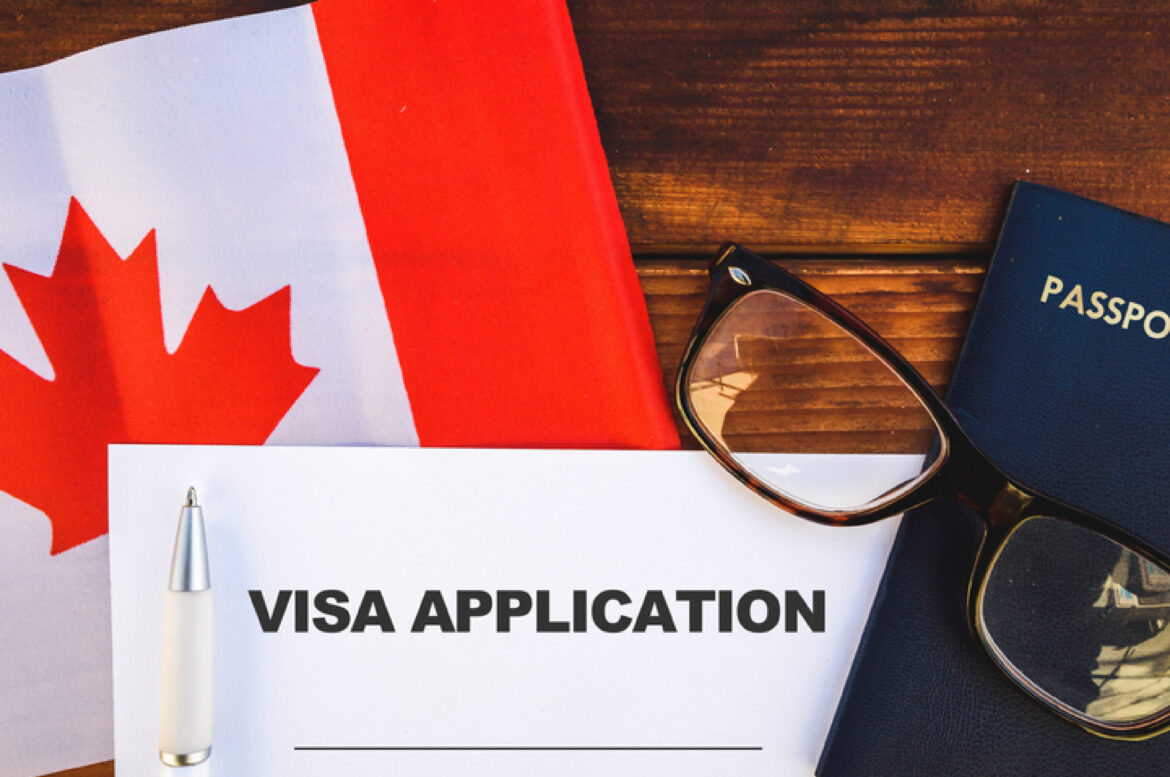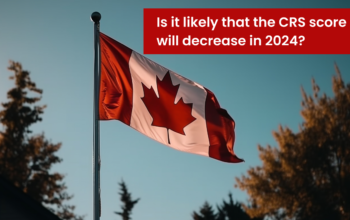People looking to move to Canada can choose from over 60 different immigration schemes. Permanent residency in Canada is a status that allows non-Canadian citizens to live and work in the country for an indefinite period of time.
A foreign national must apply to Immigration, Refugees and Citizenship Canada (IRCC), formerly known as Citizenship and Immigration Canada, through one of many categories to become a permanent resident.
More than one million new immigrants will arrive in Canada between 2020 and 2023! There are numerous ways to immigrate to Canada and obtain permanent residence, but the Canadian Team is dedicated to making things as simple as possible.
What do you mean by Canada Visa?
A visa for Canada is a stamp in your passport that authorises you to visit the nation.
It is a legal document that allows you to enter the nation and stay there temporarily or permanently. A visa to Canada signifies that the Canadian Consulate or Embassy in your home country has determined that you are eligible and meet the entrance requirements. However, it is up to the authorities at the Canadian border and customs to determine if you are fit to enter.
Who Needs a Visa to Enter Canada?
Visas are required for visitors from countries that do not have a visa exemption or an Electronic Travel Authorization (eTA) agreement with Canada. More specifically, people from roughly 148 countries need a visa to visit, work, or immigrate to Canada.
You must apply for a visa to enter Canada if you are one of these applicants. You will have a different manner of applying depending on the sort of visa you desire, but there are a few general stages you must follow.
Temporary Canada Visas
Temporary Canada visas allow visitors to stay in the country for a set length of time defined by the Canadian Consulate or Border Services Officers (BSO). This duration is frequently up to 6 months. The temporary visa, on the other hand, can be single or multiple entry.
Types of Canadian Temporary Visas:
- Canada Tourist Visa: The Visitor Visa, often known as a Tourist Visa, allows the holder to enter Canada only for tourism purposes.
- Canada Super Visa: The Canadian Super Visa permits parents or grandparents of Canadian citizens or Permanent Residents to spend time with their children or grandchildren.
- Courtesy Visa: The Courtesy Visa is granted to persons who do not meet the requirements for a Diplomatic or Official Visa but are considered important because of their rank or position. Members of trade missions or diplomats with a touristic agenda, for example, fall into this category.
- Canada Facilitation Visa: Canadian citizens with dual nationalities who do not have a Canadian passport but do have a passport of another country are eligible for a Facilitation Visa. Due to the tremendous difficulty of obtaining a Canadian passport, the facilitation visa is stamped on the person’s other nationality visa.
- Canada Temporary Work Visa: Temporary work visas in Canada are granted to those who have a job offer in Canada and want to stay for up to six months. The person must submit a legitimate employment offer letter from a company and qualify for a temporary visa in order to obtain this visa.
- Temporary Residence Permit: This visa is for individuals who require entry to Canada for a variety of reasons but are not eligible for a Temporary Resident Visa (TRV). This permission is only valid for the time the individual needs to be in Canada, such as two weeks for a workshop.
- Working Holiday Visa: The Canada Working Holiday Visa allows young people from 30 countries to work and travel in Canada. It is a random selection visa, which means that applicants will submit their applications and wait to be chosen at random to apply for a work permit.
Permanent Canada Visas
Permanent Canada visas are those that allow the person to remain in the nation indefinitely. These are sometimes known as immigrant visas and come in a variety of forms, including:
- Immigrant Investor Program: The Immigrant Investor Program is for those with a net worth of at least CAD$800,000 who want to invest in the Canadian economy. They must invest at least CAD$400,000, which the government will repay to them without interest after 5 years.
- Startup Visa Program: The Canada Startup Visa is for persons who plan to contribute to the economy on a personal level. They must have a net worth of at least CAD$300,000 and pledge to own and manage at least one-third of a Canadian firm, as well as create and retain employment, within three years after arriving in Canada.
- Self-employed Persons Visa: The Self-employed Persons visa is for persons who can create their own businesses and have abilities in business, athletics, culture, or farming. These individuals must show how they will finance the company as well as their expertise in those areas.
- Quebec-Selected Skilled Worker Program (QSWP): If you have one of the required vocations in Quebec and are proficient in French, you can apply for the Quebec Skilled Worker Program, which will allow you to move and work permanently in the province.
- Family-Sponsorship Program: The Family Sponsorship Visa permits Canadian citizens and Permanent Residents’ spouses and dependant children to immigrate to Canada permanently.
What are the different types of visas available in Canada?
- Visitor visas.
- Student visas.
- Work visas.
- Permanent Residence visas.
- Business Immigrant visas.
- Express Entry Program visas.
How to Apply for Canada Visa?
Find out these below points to know for Canada Visa Application:
1. Eligibility
The Canadian government has made it quite simple to learn how to obtain a Canadian visa. They’ve designed a variety of tests that ask applicants to fill out an online questionnaire to determine their eligibility.
You will be given numerous questions depending on the sort of visa you desire, and the system will then tell you whether you may apply or not. It will also offer you the necessary instructions and actions to follow in order to meet all of the requirements.
General eligibility requirements
- Provide proof to an officer that you will leave Canada when your Work Permit expires.
- Have documentation proving that you and your family will be able to support themselves and their families during your stay in Canada.
- Have no criminal history and provide a police clearance certificate as proof.
- Are not a security threat to Canada
- Must be in good health and willing to undergo a medical examination if necessary.
- Have no intention of working for an employer who has been deemed ineligible by the government due to a failure to meet specific requirements.
- Have no intention of working for a company that provides sexual dance, escort services, striptease, or erotic massages.
- To qualify for entrance to Canada, you must be prepared to produce any documentation requested by police.
2. Create your online account
It will be specified in the email instructions whether you must apply for a Canada visa online or in person. The majority of Canadians will have to apply online since the Canadian government is digitising its data. To do that, you must create an account.
You can create an account for the app in one of two ways:
- Because the Canadian government has partnered with several banks, you can use your online banking login.
- Creating a GCKey (Government of Canada login).
4. Pay the fees
The system will direct you to the payment page once it has verified that you have provided all of the required papers. Depending on the type of visa you are seeking for, you will have to pay Canada visa fees. Your application will be submitted after that is done.
The application will appear on your account in around 5 business days, and if you apply in person, you will only need to take those documents to the Canadian Embassy in your native country.
5. Process of Canadian Visa
Depending on the type of visa, the Canadian Embassy will process your application for two or more weeks. They may also ask for additional documents or for you to submit your biometrics and participate in an interview.
Even if you applied online, you will have to visit the Embassy in person if they request your biometrics and an interview. You must schedule an appointment, or the Embassy will do it on your behalf. You will be required to provide your fingerprints and pictures, as well as answer questions from a Canadian Embassy official, at your appointment.
Even if you did not have to submit biometrics or go through an interview, all Embassy notices on your visa will be put on your account, so you must check it frequently.
6. Submit your passport and processing fees
The next step is to submit your passport to the Canadian Embassy if you receive notification that your Canada visa application was successful. This can be done by mailing it, along with processing costs, to the Embassy’s address in your country.
The processing fees range from $20 to $50 and must be paid by check or money order, depending on the type of visa you are asking for. You’ll also need to pay for a passport return envelope.
Visa Application
You can travel to Canada once you get your visa. You will be requested to present your passport and other documentation at the point of entrance. Officials will examine them and inquire as to why you are travelling to Canada.
They will decide whether or not to let you into the country based on your response. If officials at the point of entry fear you will conduct crimes or violate your visa limitations, they have the authority to refuse you admission. Only border officials have the authority to determine whether or not you will be allowed to enter Canada with a Canadian visa.
Frequently Asked Questions
VFS Global manages Canada Visa Application Centers (CVAC) to make the visa application process easier for Immigration, Refugees, and Citizenship Canada (IRCC). Applicants can apply for a visa to Canada at any CVAC location. Additionally, permanent residents of Canada can use the CVAC’s services to apply for their Permanent Resident (PR) Card.
To begin the application procedure, applicants can do so either online or offline. Filling out the application form and sending the papers online is the online method, whereas the offline option requires the applicant to complete the application on paper. Both systems provide a variety of visa fee payment alternatives based on a variety of parameters.
Applicants of online applications can use their tracking ID and cross-reference it with their D.O.B. to get the most up-to-date status of their application, but they can also contact the CVAC by phone or email for more information.
The length of time it takes to complete an application depends on a number of criteria, including the applicant’s nationality, the correctness of the information on the application form, the authenticity of the documents supplied, the status of visa fee payment, visa type, and length of stay.
Different types of visitor visas exist. Some are single-entry visas, meaning they are only valid for one visit to Canada. Unless you are travelling to the United States or St. Pierre and Miquelon, you will need to apply for a new visa if you leave Canada and want to return.
However, some visas allow persons to leave and return to Canada many times throughout the validity of their visas.
You may need to apply for a US visa in Canada if you want to go to the United States from Canada. If you are a citizen of a nation that participates in the Visa Waiver Program, you do not need to apply for a US visa from Canada; instead, you must apply for ESTA.
The cost of a visa to Canada is determined by the type of visa you are seeking for. You must also pay other types of fees, such as a processing cost and a biometrics fee.
You must apply for a visa extension if your visiting visa in Canada is about to expire and you wish to remain longer. A Canada Visitor Record is what it’s called. At least 30 days before your visitor visa expires, you must file for a visa extension for Canada (visitor record).
You can alter your study or work permit to a Visitor Record in addition to extending a tourist visa. A visitor record, on the other hand, is only available while you are in Canada.
Before you begin the application process for a tourist visa to Canada, you must first determine whether you require one. Before you fly to Canada, check to see if you’ll need a guest visa.




